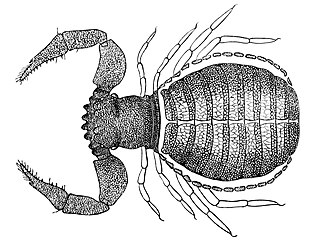
Feaellidae is a family of pseudoscorpions, first described by Edvard Ellingsen in 1906.

Feaella is a genus of pseudoscorpions in the family Feaellidae, first described by Edvard Ellingsen in 1906.
Draculoides akashae is a species of schizomid arachnids in the Hubbardiidae family. It is endemic to Australia. It was described in 2020 by Australian arachnologists Kym Abrams and Mark Harvey.
Draculoides christopherleei is a species of schizomid arachnids in the Hubbardiidae family. It is endemic to Australia. It was described in 2020 by Australian arachnologists Kym Abrams and Mark Harvey.
Draculoides immortalis is a species of schizomid arachnids in the Hubbardiidae family. It is endemic to Australia. It was described in 2020 by Australian arachnologists Kym Abrams and Mark Harvey.
Draculoides minae is a species of schizomid arachnids in the Hubbardiidae family. It is endemic to Australia. It was described in 2020 by Australian arachnologists Kym Abrams and Mark Harvey.
Draculoides noctigrassator is a species of schizomid arachnids in the Hubbardiidae family. It is endemic to Australia. It was described in 2020 by Australian arachnologists Kym Abrams and Mark Harvey.
Draculoides nosferatu is a species of schizomid arachnids in the Hubbardiidae family. It is endemic to Australia. It was described in 2020 by Australian arachnologists Kym Abrams and Mark Harvey.
Draculoides piscivultus is a species of schizomid arachnids in the Hubbardiidae family. It is endemic to Australia. It was described in 2020 by Australian arachnologists Kym Abrams and Mark Harvey.
Draculoides warramboo is a species of schizomid arachnids in the Hubbardiidae family. It is endemic to Australia. It was described in 2020 by Australian arachnologists Kym Abrams and Mark Harvey.
Draculoides affinis is a species of schizomid arachnids in the Hubbardiidae family. It is endemic to Australia. It was described in 2018 by Australian arachnologists Volker Framenau, Zoë Hamilton, Terrie Finston, Garth Humphreys, Kym Abrams, Joel Huey and Mark Harvey. The specific epithet affinis is Latin for ‘related to’ or ‘neighbouring’, with reference to its similarity to other species in the genus.
Draculoides catho is a species of schizomid arachnids in the Hubbardiidae family. It is endemic to Australia. It was described in 2018 by Australian arachnologists Volker Framenau, Zoë Hamilton, Terrie Finston, Garth Humphreys, Kym Abrams, Joel Huey and Mark Harvey. The specific epithet catho refers to the type locality.
Draculoides celatus is a species of schizomid arachnids in the Hubbardiidae family. It is endemic to Australia. It was described in 2018 by Australian arachnologists Volker Framenau, Zoë Hamilton, Terrie Finston, Garth Humphreys, Kym Abrams, Joel Huey and Mark Harvey. The specific epithet celatus refers to the discovery of the species only by molecular analysis.
Draculoides cochranus is a species of schizomid arachnids in the Hubbardiidae family. It is endemic to Australia. It was described in 2018 by Australian arachnologists Volker Framenau, Zoë Hamilton, Terrie Finston, Garth Humphreys, Kym Abrams, Joel Huey and Mark Harvey. The specific epithet cochranus refers to the type locality.
Draculoides confusus is a species of schizomid arachnids in the Hubbardiidae family. It is endemic to Australia. It was described in 2018 by Australian arachnologists Volker Framenau, Zoë Hamilton, Terrie Finston, Garth Humphreys, Kym Abrams, Joel Huey and Mark Harvey. The specific epithet confusus refers to the shared diagnostic characters of Draculoides and Paradraculoides.
Draculoides trinity is a species of schizomid arachnids in the Hubbardiidae family. It is endemic to Australia. It was described in 2018 by Australian arachnologists Volker Framenau, Zoë Hamilton, Terrie Finston, Garth Humphreys, Kym Abrams, Joel Huey and Mark Harvey. The specific epithet trinity refers to the type locality.
Draculoides obrutus is a species of schizomid arachnids in the Hubbardiidae family. It is endemic to Australia. It was described in 2018 by Australian arachnologists Volker Framenau, Zoë Hamilton, Terrie Finston, Garth Humphreys, Kym Abrams, Joel Huey and Mark Harvey. The specific epithet obrutus refers to the species only being discovered through molecular analysis.
Feaella anderseni is a species of pseudoscorpion in the Feaellidae family. It is endemic to Australia. It was described in 1989 by Australian arachnologist Mark Harvey. The specific epithet anderseni honours Alan Andersen, collector of some of the specimens.
Feaella linetteae is a species of pseudoscorpion in the Feaellidae family. It is endemic to Australia. It was described in 2016 by Australian arachnologists Mark Harvey, Kym Abrams, Amber Beavis, Mia Hillyer and Joel Huey.
Feaella tealei is a species of pseudoscorpion in the Feaellidae family. It is endemic to Australia. It was described in 2016 by Australian arachnologists Mark Harvey, Kym Abrams, Amber Beavis, Mia Hillyer and Joel Huey.
